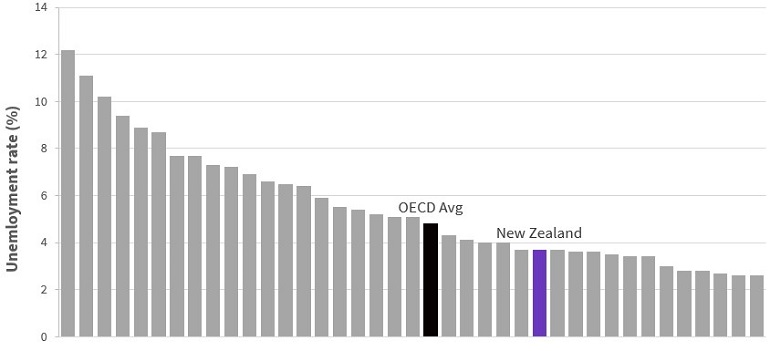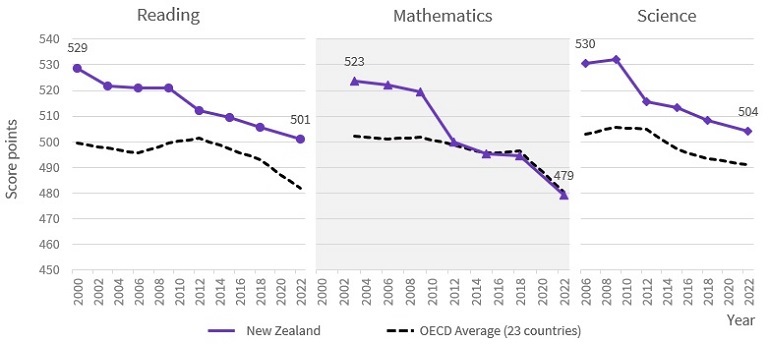Introduction
Getting people into employment and lifting economic outcomes.
On this page
New Zealand’s labour market enables firms to find the workers they need and New Zealanders to find paid work. When this system is working well, businesses, industries and sectors can grow and prosper; people can contribute to the economy and share in its prosperity; regional economies can grow; and overall labour productivity can increase. A well-performing labour market underpins a strong and sustainable fiscal position. It is at the heart of creating economic and social prosperity for current and future generations.
The New Zealand labour market is flexible and responsive but has well-known structural challenges as well as cyclical ones.
A dynamic labour market allows for high participation levels and low unemployment
Labour markets are always changing. People constantly move between jobs, in and out of employment, across countries and between regions. Young people enter from study and older workers retire. Over the course of their life, people will have different desires and expectations about working hours, pay and conditions.
In New Zealand, this ever-changing environment is generally well supported. New Zealand’s openness (ease of movement across borders) and flexibility have contributed to several broad traits of its labour market:
- Solid job growth over the longer-term, and relatively low rates of unemployment.
- Responsiveness to medium and long-term shifts in demand for labour, which supports changes in New Zealand’s economic mix and the types of sectors represented (for example, within core sectors like agriculture and in the growth of new sectors like aerospace).
- High rates of labour force participation (particularly by international standards) driven particularly by rising participation of women and older workers.
- High levels of migrant flows (both inbound and outbound) given our population size and a relatively high reliance on migrant labour to fill gaps, lift workforce skills and grow the working-age population.
Labour force participation (aged 15+) across the OECD

Source: Labour force participation rate, 15 years and over, % in same age group, 2022 – OECD (2024)
View chart description and data – Labour force participation (aged 15+) across the OECD
Unemployment rates (aged 15+) across the OECD

Source: Unemployment rate, 15 years and over, % of labour force in same subgroup, 2023 – OECD (2024)
View chart description and data – Unemployment rates (aged 15+) across the OECD
But challenges remain
Despite these strengths, there are several areas where the labour market isn’t currently delivering the kind of outcomes that support people to have a good quality of life. These include challenges in areas like productivity that are also driven by factors sitting outside the labour market. New Zealand has:
- A rate of productivity growth (GDP produced over total hours worked) that has lagged most OECD countries since the 1970s, and modest real wage growth.
- High levels of mismatch between the skills workers have and the skills firms need.
- High numbers of people reliant on Jobseeker Support Benefit.
- High inward migration, due to both offsetting New Zealanders moving to Australia and an increasing number of lower-skilled temporary workers.
- An education and training pipeline that risks not providing the right skills for current and future workforce needs.
- Persistent and serious gaps in labour market participation and outcomes for specific population groups, especially women, Māori, Pacific peoples, disabled people, migrant and ethnic communities, older workers and youth.
- Changes to the labour market from technology, climate change responses and demographic trends that may cause market shocks or make existing issues worse.
Examining New Zealand’s increased rate of income growth between the late 1990s and 2019 – Galt, M (June 2023)(external link) — New Zealand Treasury
GDP per hour worked

Source: 2015 US Dollars Purchasing Power Parity – OECD Productivity database
The productivity slowdown: implications for the Treasury’s forecasts and projections [PDF, 603 KB] — New Zealand Treasury
View chart description – GDP per hour worked
New Zealand PISA scores

Source: PISA 2022 Database, Tables I.B1.5.4, I.B1.5.5 and I.B1.5.6 – OECD
View chart description and data – New Zealand PISA scores
The immediate outlook shows the economy will gradually strengthen
Over the last few years, the economy has faced high inflation, high costs of living, increased unemployment and working-age benefit numbers, and even higher net migration levels than pre-COVID-19, which were already high. Looking to the immediate future, New Zealand has an improved outlook from the second half of 2024, with inflation coming under control, interest rates dropping and growth recovering. The effective management of these kinds of short-term challenges is important in ensuring they do not become more embedded. For instance, the longer someone is out of work:
- A rate of productivity growth (GDP produced over total hours worked) that has lagged most OECD countries since the 1970s, and modest real wage growth.
- High levels of mismatch between the skills workers have and the skills firms need.
- High numbers of people reliant on Jobseeker Support Benefit.
- High inward migration, due to both offsetting New Zealanders moving to Australia and an increasing number of lower-skilled temporary workers.
- An education and training pipeline that risks not providing the right skills for current and future workforce needs.
- Persistent and serious gaps in labour market participation and outcomes for specific population groups, especially women, Māori, Pacific peoples, disabled people, migrant and ethnic communities, older workers and youth.
- Changes to the labour market from technology, climate change responses and demographic trends that may cause market shocks or make existing issues worse.
Back to Work: New Zealand: Improving the Re-employment Prospects of Displaced Workers(external link) — OECD.org
Budget Economic and Fiscal Update 2024 [PDF, 1.51 MB](external link) — New Zealand Treasury
Strengthening the New Zealand economy and improving productivity will be vital to delivering prosperity now and into the future.
The challenges and trends identified present both risks and opportunities to the New Zealand economy.
We must work together to ensure we have stable foundations to deliver the economic conditions that will support New Zealand’s prosperity now and into the future. This Government has 5 pillars for growth: building infrastructure for growth and resilience; lifting educational achievement and skills; strengthening trade and investment; promoting innovation, science, and technology; and improving regulation. A well-functioning labour market has a critical role to play in supporting that growth as well as delivering jobs and raising living standards for New Zealanders.
Delivering a more prosperous and resilient New Zealand economy will require the government to play several crucial and complementary roles in the labour market across businesses, central and local government, Māori and communities. This includes setting clear objectives, working collaboratively across portfolios and taking a forward-looking approach to regulatory settings and investments.
Our targets
To improve outcomes for New Zealanders in health, education, law and order, work, housing and the environment, the Government has identified 9 targets in a range of areas that support the economy and population. Several of these targets, outlined below, directly influence the labour market.
Headline target
Fifty thousand fewer people on the Jobseeker Support benefit by 2030
The Government’s focus on reducing benefit dependency is about supporting people into work – so that New Zealanders can reap the independence and opportunities that come from work, helping families break out the vicious cycles of inter-generational welfare dependence.
Connections to other key Government targets
Increased student attendance
80% of students are present for more than 90% of the term by 2030.
Attendance is the first step in accessing learning, achieving education success and improving wellbeing and lifelong outcomes (including employment).
More students at expected curriculum levels
80% of Year 8 students at or above the expected curriculum level for their age in reading, writing and maths by December 2030.
Literacy and numeracy are the foundation of all learning. Mastering the basics will set children and young people up for success, meaning they will leave school equipped with the knowledge and skills needed to achieve their potential.
Fewer people in emergency housing
75% fewer households in emergency housing by 2030.
Stable and secure housing reduce the long-term social and financial cost on people from living in emergency housing for long periods. It can help improve outcomes for health, education, employment and the wider community.
This Government’s work will enable New Zealand to become wealthier, support our people to earn more and live better, and create strong foundations for future generations to succeed.
This Employment Action Plan sets out what we will do to lift labour market outcomes, which are key to achieving the Government’s targets and getting results for New Zealand
This Employment Action Plan is about getting more New Zealanders into work, improving labour market outcomes for everyone and supporting us to achieve our targets. It sets clear goals and expectations and takes a long-term approach to labour market settings and investments. It requires all of us to make the most of the opportunities we have so that we can maximise the potential that every New Zealander has to offer.
New Zealand’s challenges are a mix of structural and cyclical issues. This Employment Action Plan focusses on key actions that will make a difference: ensuring young people get an education that sets them up for success, supporting people into work, helping families deal with the cost of living, responding to the workforce needs of industries and communities to enable businesses to thrive, and delivering on the priorities we’ve set.
The vision and goals in this plan directly link to improving skills and employment outcomes and meeting workforce needs. It recognises that there are strong dependencies and relationships across government, with actions being undertaken through 5 core Labour Market Ministers Group portfolios: Social Development and Employment, Education, Tertiary Education and Skills, Regional Development and Immigration.
By working together, the government is better at problem-solving and gets better outcomes. For example, work to support students to achieve at higher levels enables them to get jobs and to make the most of access to training and upskilling. This then means that people can better support their families in the regions they live and the sectors they work in, and support future generations to higher achievements.

